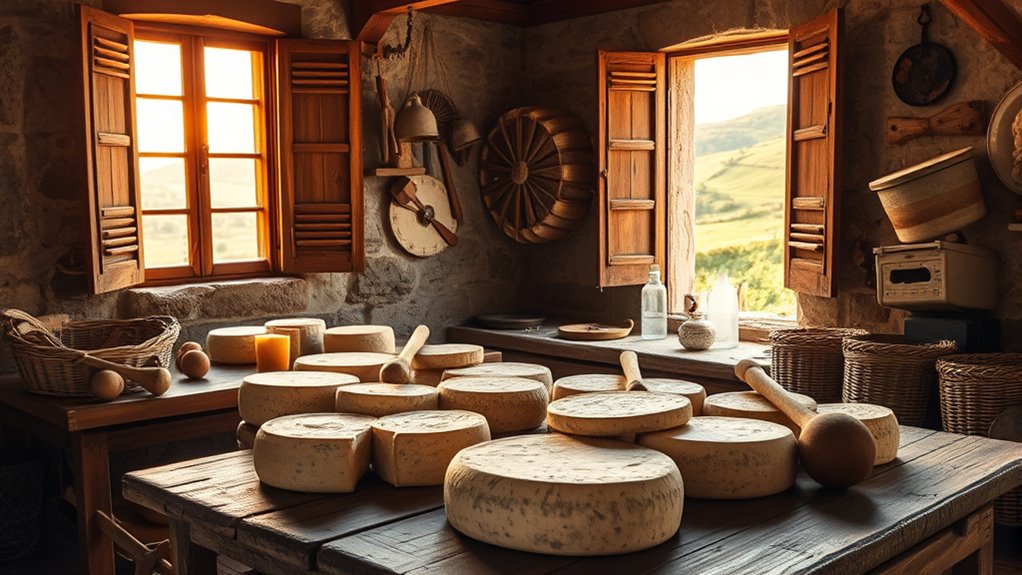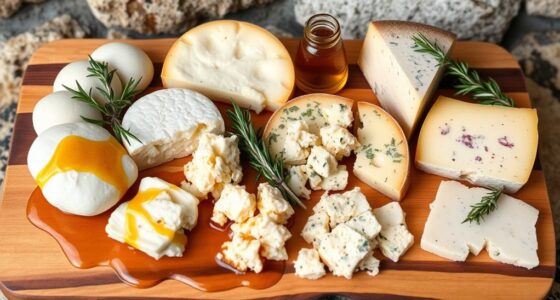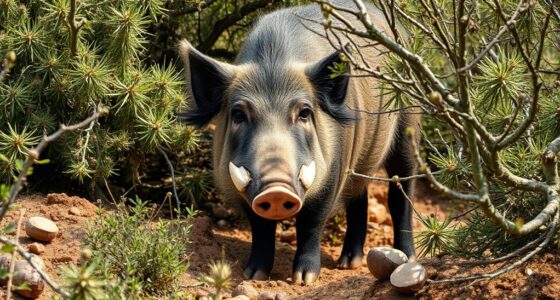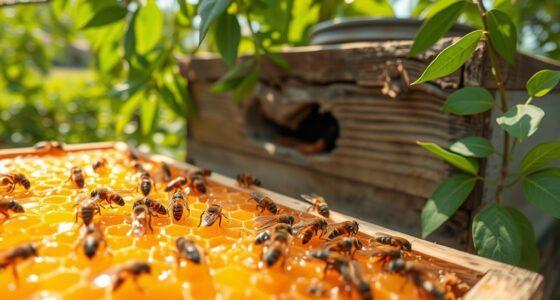You’ll discover that Sardinian cheese-making dates back over 3,500 years, rooted in ancient pastoral traditions involving sheep and goats. Over time, regional varieties like Pecorino Sardo and Fiore Sardo developed, with ancient methods preserved through family traditions. The shift of Pecorino Romano production to Sardinia in the 19th century boosted exports, while modern influences have blended old techniques with new technologies. Continue exploring to uncover the deep cultural roots and evolving craft behind Sardinian cheeses.
Key Takeaways
- Sardinian cheese-making dates back over 3,500 years to the Nuragic civilization, with archaeological evidence of ancient dairy tools.
- Traditional cheeses like Pecorino Sardo and Fiore Sardo have origins rooted in early sheep and goat milk practices.
- The migration of Pecorino Romano production to Sardinia in the 19th century expanded regional cheese industry.
- Medieval pastoral expansion and family artisanal techniques preserved Sardinian cheese craftsmanship across generations.
- Modern industry combines traditional methods with technological advancements, maintaining cultural heritage while enhancing production.
Origins of Sardinian Cheese-Making
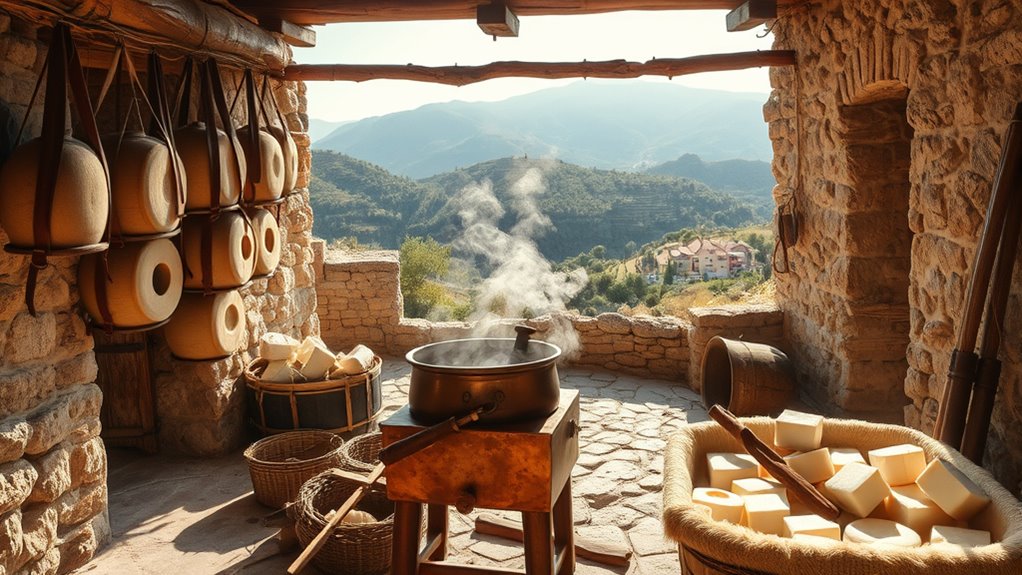
Have you ever wondered how Sardinian cheese-making began? It dates back over 3,500 years to the Nuragic civilization, an ancient culture native to the island. Back then, early cheeses were primarily made from sheep and goat milk, essential to their pastoral lifestyle. Archaeological finds, including cheese-making tools from the Bronze Age (1800–900 BC), confirm this long-standing tradition. The Nuragic people depended on agriculture and sheep farming, with cheese production playing a crucial role in their daily sustenance. Their simple, early cheeses laid the groundwork for Sardinia’s rich cheese craft that continues today. Sheep milk, especially raw and fresh, became the cornerstone of their cheese, shaping the island’s dairy practices and cultural identity for generations. Additionally, archaeological evidence demonstrates how ancient techniques have influenced modern Sardinian cheese-making methods.
Medieval and Early Modern Developments
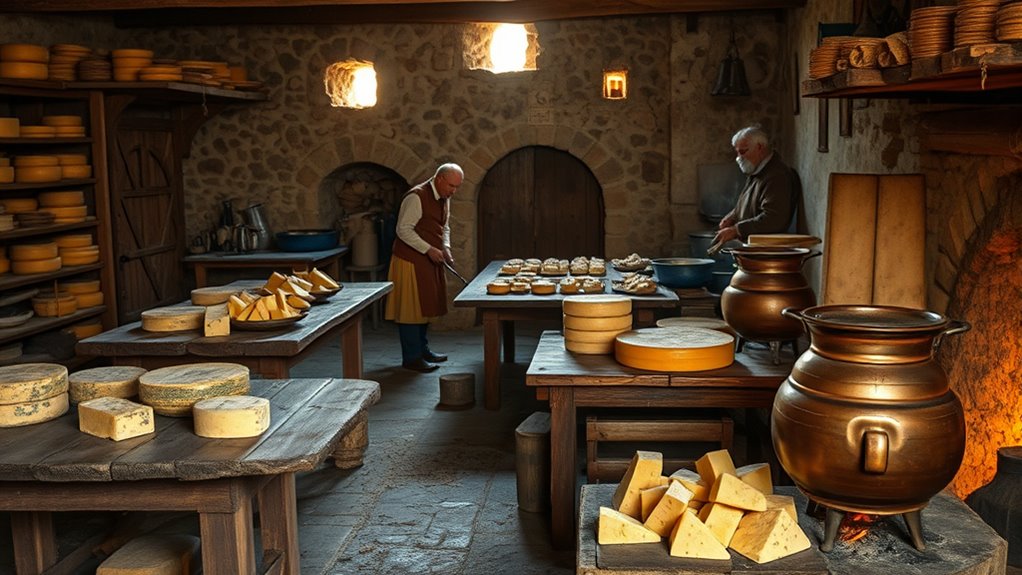
During the medieval and early modern periods, Sardinia’s pastoral agriculture expanded, supporting a variety of regional cheese types. You’ll see how artisanal techniques were passed down through families, preserving unique traditions amid changing economic conditions. These developments strengthened Sardinia’s reputation for distinctive cheese-making and regional identity. Sheep farming became increasingly organized, laying the groundwork for the diverse cheese varieties that would define Sardinian dairy products. The establishment of local cheese markets facilitated trade and the dissemination of traditional methods across communities.
Growth of Pastoral Agriculture
The growth of pastoral agriculture in Sardinia during the medieval and early modern periods was shaped by a structured legal framework and the influence of monastic communities. The Byzantine Rural Code guided land use and farming practices until late in the 13th century, after which local laws like the Carta de Logu regulated rural activities. Monasteries, especially Benedictine orders, introduced new techniques and organized land for sheep and pig farming, essential for cheese production. The social hierarchy affected land management and diet, with wealthier classes consuming more meat and cheese. Pastoralism thrived in upland areas, supported by aristocratic estates and monastic landholdings. This combination fostered a resilient pastoral economy, laying the groundwork for Sardinia’s enduring cheese traditions. The development of agricultural laws further reinforced land management and livestock practices.
Regional Cheese Varieties
Medieval and early modern Sardinia saw the emergence of distinctive cheese varieties that reflect the island’s rich pastoral traditions. You can find cheeses like:
- Fiore Sardo PDO: Known for its smoky aroma, it’s been crafted since the Bronze Age from sheep’s milk, matured on reeds near fire.
- Pecorino Sardo PDO: Available in mild (Dolce) and mature (Maturo) forms, it’s one of Sardinia’s oldest cheeses, made with traditional methods.
- Pecorino Romano: Originating from Sardinia, this cheese—used widely in Roman cuisine—is made from sheep’s and goat’s milk and often grated. The traditional cheese-making techniques employed during these periods emphasize the importance of natural materials and rustic methods.
Artisanal Cheesemaking Traditions
Artisanal cheesemaking in Sardinia during the medieval and early modern periods built upon centuries of pastoral traditions rooted in the island’s Nuragic civilization. You rely on age-old practices passed down through generations, focusing on sheep and goat milk, and later, cow milk from indigenous breeds like Sardinian-Bruno and Sarda-Modicana. Most cheesemaking remained a domestic craft, often led by women skilled in curd kneading and fermentation. You use natural lactic fermentation, requiring patience and careful timing to develop the right texture. Traditional tools like the “spino” for breaking curd and hand-stretching techniques are essential. Sardinia’s unique sheep breeds and the island’s climate contribute to distinctive flavors and textures that define Sardinian artisanal cheese. These methods emphasize manual skills, minimal mechanization, and a deep connection to land and environment, fostering unique flavors and textures that define Sardinian artisanal cheese. The preservation of these traditional methods continues to influence modern cheesemaking practices on the island.
The Shift of Pecorino Romano Production to Sardinia
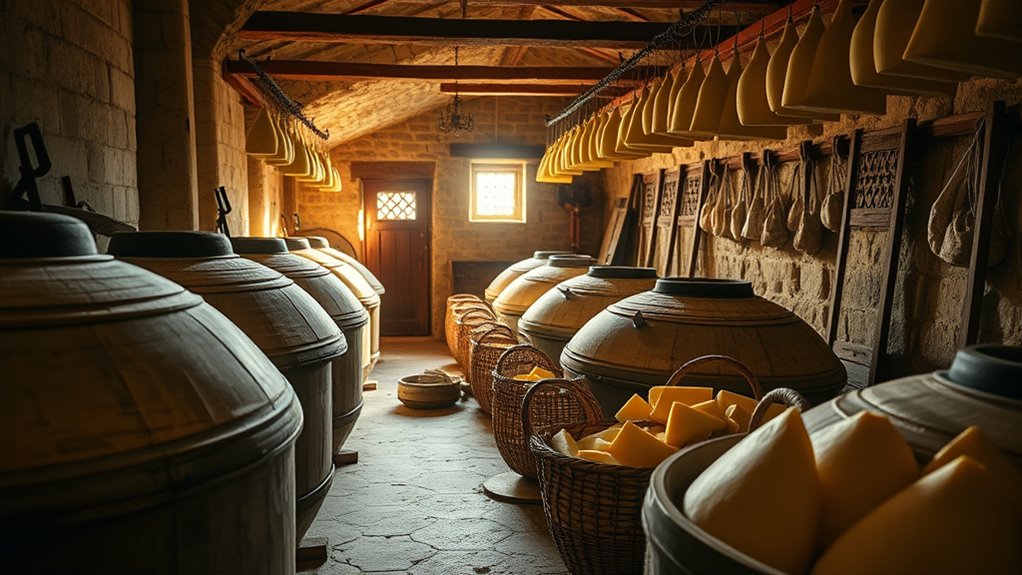
During the 19th century, a significant migration of Pecorino Romano production shifted from Lazio to Sardinia, driven by cheesemakers seeking better resources and favorable conditions. Sardinia’s abundant sheep flocks, especially the Sarda breed, and its ample grazing land made it an ideal location. Additionally, a law in 1884 banned salting cheese within Rome, pushing production outside the city and toward Sardinia. This move allowed Sardinian dairies to expand and export Pecorino Romano widely. The island’s climate and flora further enhance the cheese’s distinctive flavor profile.
Traditional Methods and Regional Varieties
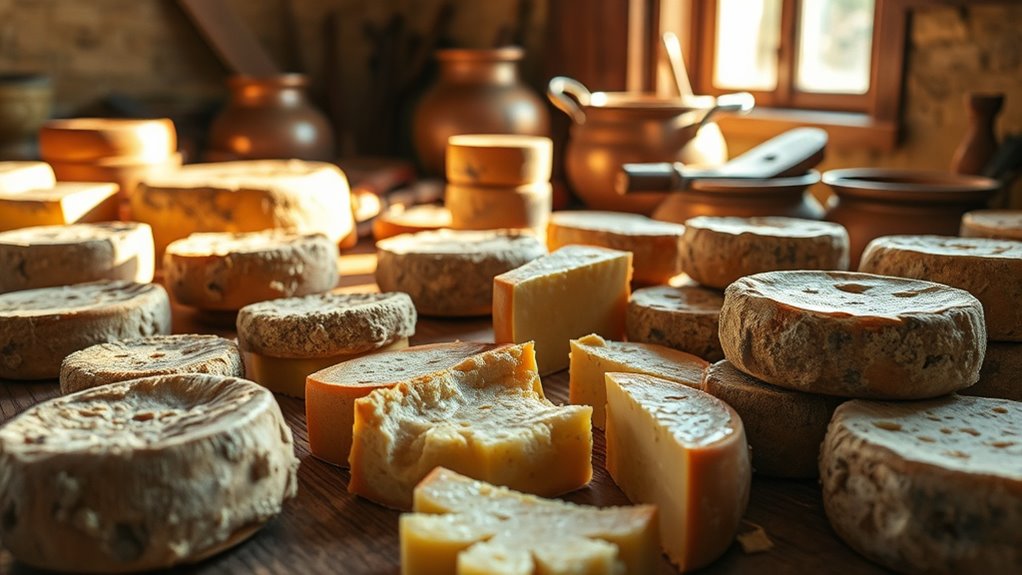
Traditional cheese-making in Sardinia relies on time-honored techniques that emphasize natural materials and local expertise. You’ll find that sheep’s milk is the primary ingredient, often combined with cow’s milk or blends. Milk is heated and coagulated with natural lamb rennet made by shepherds, ensuring authentic flavor and texture. The curd is carefully cut, separated from whey, molded, and pressed to shape the cheese. Salting through brining, lasting 8 to 12 hours per kilogram, enhances flavor and preservation. Aging occurs in caves or rooms with controlled temperature, sometimes for months, with regular maintenance like greasing with wine vinegar, olive oil, and salt. Regional varieties like Fiore Sardo, Pecorino di Osilo, and Casu Marzu showcase unique flavors shaped by microclimates, diet, and traditional craftsmanship. Additionally, the regional climate plays a crucial role in influencing the aging process and final taste of Sardinian cheeses.
Postwar Migration and Industrialization Effects
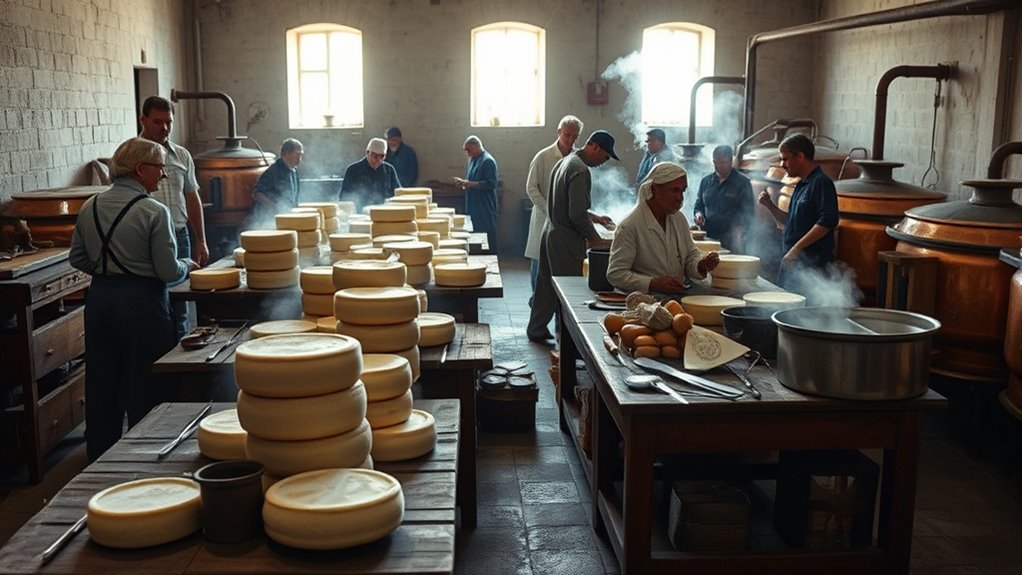
Migration after World War II brought Sardinian cheesemaking skills to mainland Italy, blending regional traditions and expanding production. Industrialization transformed the craft with mechanized processes, but many still aim to preserve heritage methods. This shift raises questions about balancing modernization with the preservation of Sardinia’s cheese identity. Today, Sardinian cheese continues to be celebrated worldwide, highlighting its enduring cultural significance. Efforts to maintain traditional techniques amid industrialization are crucial for sustaining regional authenticity and unique flavors.
Migration’s Impact on Techniques
Postwar migration and industrialization considerably transformed Sardinian cheese techniques by fostering a dynamic exchange of methods and knowledge. You now see how regional cheesemaking evolved through the blending of traditions and innovations. Here are three key impacts:
- Sardinians shared pastoral techniques and recipes during migration, enriching mainland cheese practices.
- Mainland cheesemakers introduced industrial processes and modern technologies to Sardinia, increasing efficiency and consistency in production.
- Hybrid methods emerged, balancing traditional salting and aging with modern climate adaptations, creating regional variations. Technological advancements played a significant role in shaping these new approaches.
This exchange led to more standardized production across Italy while preserving unique regional traits. Advanced technologies like computerized monitoring combined with traditional methods, broadening the scope of Sardinian cheese craftsmanship. The result is a vibrant, evolving industry grounded in history but driven by innovation. This ongoing exchange has also helped safeguard traditional knowledge by adapting it to contemporary production needs.
Preservation of Heritage Methods
Despite the waves of modernization brought by industrialization, many Sardinian cheese producers have actively worked to preserve their heritage methods. They continue using traditional techniques like natural whey starters, wooden molds, and smoking over wood to maintain authentic flavors. Family involvement plays a vital role in passing down manual skills and knowledge across generations. Many producers still employ raw, unpasteurized milk and time-honored aging procedures, resisting industrial shortcuts. Traditional brining, aging in natural environments, and manual curd handling remain central to their craft. While industrialization introduced mechanized equipment and environmental controls, some cheesemakers integrated technology to improve hygiene and consistency without abandoning tradition. Certification standards like PDO help enforce heritage standards, ensuring these methods are preserved and recognized internationally. Additionally, the importance of traditional methods is often reinforced through local festivals and cultural celebrations that highlight Sardinian cheese-making heritage.
Cultural Significance and Economic Impact
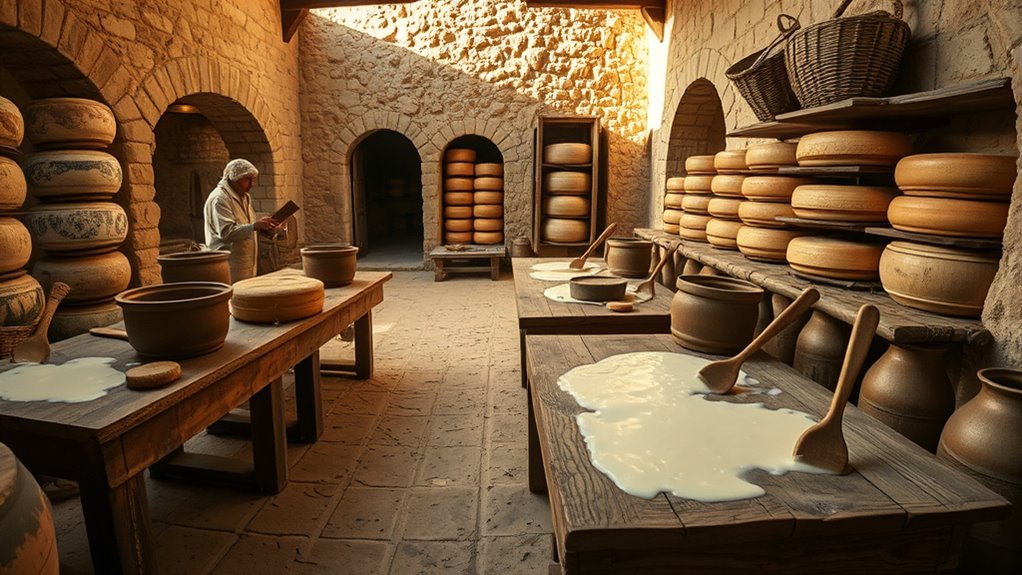
Cultural significance and economic impact are deeply intertwined in Sardinia’s cheese production. You’ll see how cheese reflects local traditions and strengthens community bonds. Here are three key points:
- Sardinian cheeses like Fiore Sardo symbolize shepherding culture, with roots dating back to the Bronze Age.
- Sharing cheese, especially gifting pecorino, enhances social ties and preserves rituals passed through generations.
- Cheese has historically driven the economy, supporting small farms and international markets, with legal and illegal trade thriving. Cheese plays a vital role in sustaining local livelihoods and fostering regional identity.
These cheeses are more than commodities—they embody Sardinia’s heritage, folklore, and identity. Despite modern challenges, they continue to connect past and present, making cheese a essential part of the island’s cultural and economic fabric.
Frequently Asked Questions
How Has Sardinian Cheese Evolved Over the Last Century?
You’ve seen Sardinian cheese evolve from traditional, handcrafted methods to a blend of heritage and modern techniques. Today, production balances artisanal practices with advanced technology like temperature-controlled aging and precise salting. You’ll find more variety, often flavored with local herbs, and different milk types, including cow’s milk. Despite innovations, the focus remains on preserving quality, taste, and cultural traditions, making Sardinian cheese a unique and celebrated part of Italy’s culinary landscape.
What Influences the Flavor Profiles of Different Sardinian Cheeses?
You might notice that Sardinian cheeses have diverse flavors, and it’s no coincidence. The type of milk—sheep, goat, or cow—shapes their taste, especially when raw, capturing the unique pastures and seasons. Aging, from months to years, deepens flavors, while traditional techniques like smoking and rind-rubbing add complexity. Regional climates and local flora further influence these cheeses, making each one a flavorful reflection of Sardinia’s nature and craftsmanship.
Are There Specific Festivals Celebrating Sardinian Cheese Traditions?
You’ll find that Sardinian cheese traditions are celebrated through various regional festivals and cultural events. These festivals often showcase tastings, demonstrations, and contests featuring cheeses like Pecorino Sardo and Fiore Sardo. Participating in these events, you get to experience the rich heritage firsthand, with community activities, traditional rituals, and local cuisine. They’re a vibrant way to appreciate Sardinia’s pastoral history and artisanal craftsmanship.
How Do Modern Regulations Protect Sardinian Cheese Heritage?
Imagine a shield guarding Sardinian cheese’s soul—modern regulations do just that. They guarantee your favorite Pecorino Sardo remains authentic, from pasture to plate. Strict rules on ingredients, animal management, and safety prevent imitations, while traceability keeps the cheese’s story transparent. International awards and quality standards reinforce its heritage. These regulations weave tradition and safety into a tapestry, preserving Sardinian cheese’s rich legacy for generations to come.
What Are the Challenges Facing Sardinian Cheese Producers Today?
You face several challenges as a Sardinian cheese producer today. Milk prices fluctuate, squeezing your profit margins and pushing you to diversify or cut costs. International competition, trade barriers, and changing consumer preferences pressure you to maintain high quality and authenticity. Environmental regulations and health issues further complicate production, while balancing tradition with innovation remains a constant struggle to stay relevant and competitive in a global market.
Conclusion
Today, Sardinia produces over 15,000 tons of cheese annually, showcasing its rich heritage. You can see how traditional methods still influence regional varieties, keeping the culture alive. The island’s cheese industry supports thousands of local farmers and artisans. As you explore Sardinian cheese, remember that this vibrant history has shaped a thriving economy, blending ancient techniques with modern innovation, ensuring the island’s cheesy legacy endures for generations to come.
